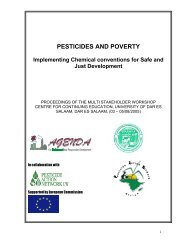Your Daily Poison - Pesticide Action Network UK
Your Daily Poison - Pesticide Action Network UK
Your Daily Poison - Pesticide Action Network UK
Create successful ePaper yourself
Turn your PDF publications into a flip-book with our unique Google optimized e-Paper software.
22<br />
◆ Further tests may be required if there<br />
is a need to understand effects<br />
better, for example on particular<br />
organ systems such as the nervous,<br />
immune or endocrine systems.<br />
On the basis of these data, regulators<br />
decide whether the product needs to be<br />
labelled as a hazard (for example,<br />
irritant, harmful, toxic). ‘Acceptable’<br />
levels of exposure are also defined,<br />
expressed as the Acceptable <strong>Daily</strong><br />
Intake (ADI), Acute Reference Dose<br />
(ARfD), Acceptable Operator Exposure<br />
Level (AOEL) and others.<br />
Acceptable <strong>Daily</strong> Intake (ADI)<br />
This is the amount of a chemical which<br />
can be consumed every day for a<br />
lifetime in the practical certainty, on the<br />
basis of all known facts, that no harm<br />
will result. It is expressed in<br />
milligrammes of the chemical per<br />
kilogramme bodyweight of the<br />
consumer. The starting point for the<br />
derivation of the ADI is usually the<br />
lowest ‘no adverse effect level’ (NOAEL)<br />
that has been observed in animal<br />
studies of toxicity. This is then divided<br />
by an uncertainty factor (most often<br />
100) to allow for the possibility that<br />
animals may be less sensitive than<br />
humans and also to account for possible<br />
variation in sensitivity between<br />
individuals. The studies from which<br />
NOAELs and ADIs are derived are<br />
supposed to take into account any<br />
impurities in the pesticide active<br />
ingredient as manufactured, and also<br />
any toxic breakdown products<br />
(metabolites) of the pesticide, but can<br />
only do so if and when these have been<br />
identified.<br />
Acute Reference Dose (ARfD)<br />
The definition of the ARfD is similar to<br />
that of the ADI, but it relates to the<br />
amount of a chemical tha can be taken<br />
at one meal or on one day. It is<br />
normally derived by applying an<br />
appropriate uncertainty factor to the<br />
lowest NOAEL in studies that assess<br />
acute toxicity or developmental toxicity.<br />
Acceptable operator exposure level<br />
(AOEL)<br />
This is intended to define a level of daily<br />
exposure that would not cause adverse<br />
effects in operators who work with a<br />
pesticide regularly over a period of days,<br />
weeks or months. Depending on the<br />
pattern of use, a short-term AOEL (ie for<br />
exposures over several weeks or on a<br />
seasonal basis), or long-term AOEL (ie<br />
for repeated exposures over the course<br />
of a year) are defined. AOELs are<br />
normally derived from a short-term<br />
laboratory animal toxicity study or a<br />
multi-generation study.<br />
Maximum Residue Level (MRL)***<br />
<strong>Pesticide</strong> residues in food are controlled<br />
through <strong>UK</strong> regulations which lay down<br />
maximum residue levels. MRLs are not<br />
safety limits for residues in food. They<br />
are designed to check that pesticides are<br />
being used correctly, according to good<br />
agricultural practice (GAP). In order to<br />
avoid serious inconsistencies in MRLs<br />
between countries, the Codex<br />
Alimentarius Commission (a United<br />
Nations body) has established the Codex<br />
Committee on <strong>Pesticide</strong> Residues, which<br />
bases its work on the scientific approvals<br />
made by the Food and Agriculture<br />
(FAO)/World Health Organisation (WHO)<br />
Joint Meeting on <strong>Pesticide</strong> Residues****.<br />
Where there is no approved use of a<br />
pesticide nor an ‘import tolerance’ a<br />
residue level is set at the limit of<br />
determination (LOD) (an affective ‘zero’<br />
reflecting the lowest level at which<br />
reliable quantitative analysis can be<br />
performed).<br />
Sources<br />
* A guide to the regulation of pesticides in the <strong>UK</strong> and<br />
the role of the Advisory Committee on <strong>Pesticide</strong>s, ACP<br />
14 (299/2003), Department for the Environment, Food<br />
and Rural Affairs and Health & Safety Executive, June<br />
2003 www.pesticides.gov.uk<br />
** Home Office, Statistics of Scientific Procedures on<br />
Living Animals in Great Britain, 2004, Stationery Office.<br />
*** Annual report of the <strong>Pesticide</strong> Residues Committee<br />
2002.<br />
**** Control of pesticides and IPM, Implementation of<br />
Farmer Participatory Integrated Pest Management and<br />
Better Chemical Management in ACP States,<br />
Directorate-General for Development, Commission of<br />
the European Communities, <strong>Pesticide</strong>s Trust, June<br />
1998.<br />
For concerns about the regulatory testing<br />
and assessment of pesticides see<br />
page 15.<br />
<strong>Your</strong> daily poison:

















